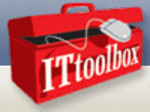 David Meerman Scott hosted a panel entitled "Advertising and PR for Everyone: Who is Winning the Race for Marketing Dollars?"
David Meerman Scott hosted a panel entitled "Advertising and PR for Everyone: Who is Winning the Race for Marketing Dollars?"
The panelists included Ben Edwards, Director, New Media Communications at IBM and Colleen DeCourcy, Chief Experience Officer for JWT. Manning Field, SVP Branding & Advertising for Chase Card Services was a last-minute no-show. (Thanks for the heads up, Manning. Oh, apparently there was no heads-up, just an empty chair. Of course, Ben and Colleen were strong enough that no one noticed.)
David laid the foundation that for companies who have relied upon having great products for their growth, that's no longer enough. The traditional marketing and advertising models no longer work. He described how IBM today has 300 RSS feeds which they use their buyers directly. They have a portal of all their blogs. IBM also offers podcasts, for example, 10 minutes from their top IP attorney.
IBM has even developed content for Youtube - for example, this Art of the Sale series of mockumentaries.
Ben expanded that at IBM, they have a very open and permissible environment for self-publishing, available to any employee (over 380,000) worldwide. They provide tools to their employees for blogging, podcasting and more. Ben's role is to help market those blogs so the audience can find what they need more easily. Internally, they have about 3,000 - 4,000 active bloggers, while externally there are many more.
Ben is also involved in marketing communications. His focus is to move from a traditional marketing approach (high cost, low frequency, low interaction) to the publishing approach (high volume, low cost, high-touch content).
Storytelling becomes much more important in this new environment. "Brand Journalism" is how Ben looks at it. Today, the narrative is no longer under control of mass media. Even though it's IBM's view, the audience is sophisticated enough to understand that it is a biased view, but that it is still worthwhile.
 According to Colleen, the old "dead" approach to creative is the aim, target, kill approach to advertising. By the time you do that, it's irrelevant. Experience is the new place where agencies need to be, so you can react and respond to remain relevant.
According to Colleen, the old "dead" approach to creative is the aim, target, kill approach to advertising. By the time you do that, it's irrelevant. Experience is the new place where agencies need to be, so you can react and respond to remain relevant.
In terms of new advertising models, Ben describes that IBM "would love to have a small, IBM-branded video widget that users could browse various video content to watch, that would be installed on various web properties which reach our targeted audience. We would pay a lot for something like that." Colleen followed that "We've been working to develop branded hubs, where we can reach a specific audience with various types of content. Unfortunately, no one knows how to price or sell that and is concerned with how that content will distract from their own content."
In closing, David asked whom they expected to win the advertising dollars five years out. Colleen, in a politically correct answer, indicated that "the clients will be the winners. We are seeing smarter use of partnerships between multiple agencies and multiple platforms, with the client really controlling the process. The clients are making the agencies become more cost-efficient and adaptable."
Ben described an environment where "the people who can grab these dollars are those who can publish. This will include traditional publishers, micropublishers, agencies who learn this world and the companies themselves, as more companies take on these tasks in house."
For more on this topic, check David's blog over the next few days. And, of course, watch for his upcoming book, the New Rules of Marketing and PR.
 Staci Kramer, of PaidContent, interviewed the leaders of the online divisions of leading consumer magazines, Jeff Price, President of SI.com and Forbes.com CEO Jim Spanfeller.
Staci Kramer, of PaidContent, interviewed the leaders of the online divisions of leading consumer magazines, Jeff Price, President of SI.com and Forbes.com CEO Jim Spanfeller. SI.com is the only fully integrated online brand at Time Warner. Conversely, Forbes Online is a separate operating unit from the Forbes print product. According to Spanfeller, their readers use the two products very differently. They have separate ad sales businesses. Jim feels that is helpful, as media buyers typically make separate buying decisions and online also requires very different sets of skills, metrics and support structures than in print.
SI.com is the only fully integrated online brand at Time Warner. Conversely, Forbes Online is a separate operating unit from the Forbes print product. According to Spanfeller, their readers use the two products very differently. They have separate ad sales businesses. Jim feels that is helpful, as media buyers typically make separate buying decisions and online also requires very different sets of skills, metrics and support structures than in print.  For SI, the value of bringing it together was important; the SI advertisers were cross-platform and channel-independent. This creates a team of about 45 sales execs who are franchise experts that could push all of their channels. That wouldn't have been possible a few years ago; they needed to first demonstrate the value and ROI of the online channel, so it didn't simply become a throw-in for print sales. But, now that they have established that value, the model better suits their clients' needs. On the editorial side, it's been easier. Their top writers, like Tom Verducci or Peter King, are thinking about the needs of the sports fan 24x7. The writers have, in fact, led the migration on
For SI, the value of bringing it together was important; the SI advertisers were cross-platform and channel-independent. This creates a team of about 45 sales execs who are franchise experts that could push all of their channels. That wouldn't have been possible a few years ago; they needed to first demonstrate the value and ROI of the online channel, so it didn't simply become a throw-in for print sales. But, now that they have established that value, the model better suits their clients' needs. On the editorial side, it's been easier. Their top writers, like Tom Verducci or Peter King, are thinking about the needs of the sports fan 24x7. The writers have, in fact, led the migration on










































